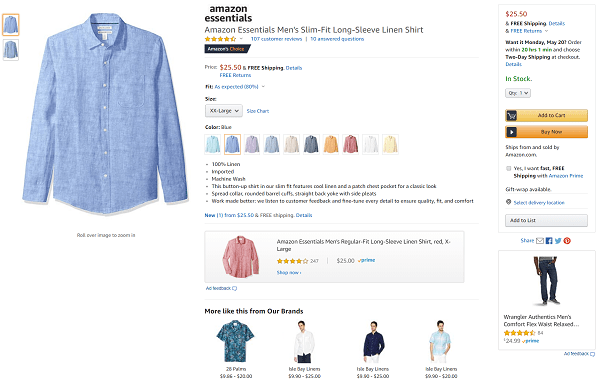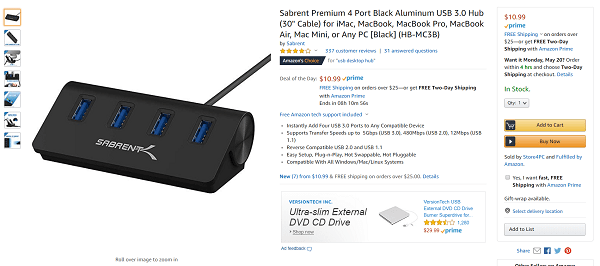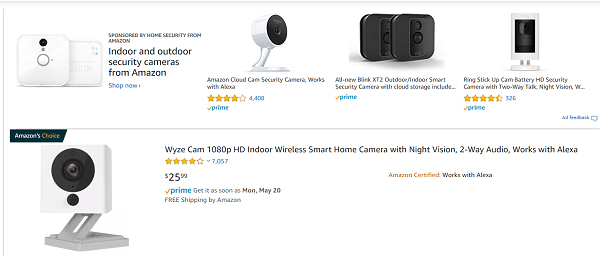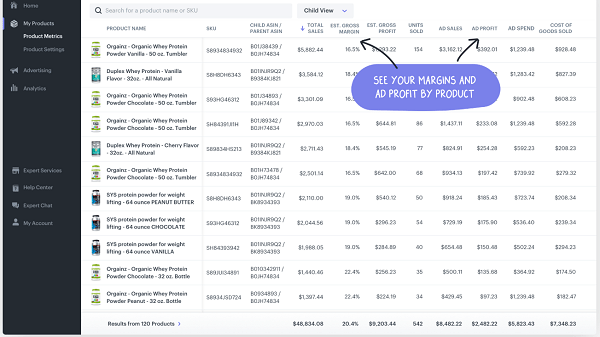Amazon Sponsored Products are the most popular Amazon advertising option, used by 29% of brands in one survey conducted by Cowen and Co. It’s easy to see why these ads are so popular: Amazon Sponsored Products ads are similar to Google’s product listing ads, allowing you to promote individual products with precise keyword targeting. These ads appear on search results pages and product detail pages, making them appealing for advertisers who want to secure a spot in specific keyword searches or on specific product detail pages.
An Overview of Amazon Sponsored Products

Screenshot via Amazon
Amazon Sponsored Products are pay-per-click ads used to drive traffic to individual product detail pages through keywords and product targeting. These ads appear in several locations including:
- At the top of search results pages
- At the bottom of search results pages
- On the right-hand side of search results pages
- In organic search results
- On product detail pages in the carousel
Where (and when) your Sponsored Products ads appear depends on where your bid lands among other bids for the same keywords or targeting the same product detail pages.
Products promoted with Sponsored Products campaigns must meet certain criteria including:
- Must be eligible for the Buy Box (your product’s price can’t be too high, and your rating can’t be too low)
- Must be able to be shipped to all addresses in the U.S.
These ads are ideal for brands launching a new product that want to drive some immediate reach, or if you have inventory that’s about to go out of season that you want to sell quickly. They’re also useful for resellers who want to breathe some life back into a declining sales rank.
How Amazon Sponsored Products Works

Screenshot via Amazon
Amazon Sponsored Products uses an auction-based pricing model similar to Google AdWords. In the simplest terms, you decide on a product to promote, choose a set of keywords to target, set your cost-per-click (maximum bid), and reap the benefits when your ads are shown to shoppers.
You pay for clicks, not views, and if your product detail pages are effective, you’ll convert at least some of those clicks to buyers. It’s a bit more complicated than that, though – but the complexities can work to your advantage if you understand how to leverage them.
Tips for Successful Amazon Sponsored Products Campaigns
The Amazon advertising system is complex, but you can run successful Amazon Sponsored Product campaigns when you understand the tricks of the trade. Below, we’ll cover the essentials you need to know to set up a successful campaign.
Use the “Explore and Exploit” Strategy

Screenshot via Amazon
Sellers using Amazon Sponsored Products can choose to run automatic or manual campaigns. The primary (and arguably most important) difference between the two is that automatic campaigns do not have keywords. Instead, ads are served for any relevant customer searches based on information from the product detail page. If you use the automatic option, ensuring that your product detail page is thorough and well-targeted is a must.
Manual campaigns, on the other hand, target ads based on the keywords you select. You can have up to 1,000 keywords in an ad group. Advertisers can set bids either at the ad group level or the keyword level, giving you a bit more control over your ad spend and targeting.
It’s helpful to run an automatic campaign to gather some essential data and identify the best-performing keywords. Then, run a manual campaign for the same products, using those top-performing keywords. We call this strategy “Explore and Exploit,” using automatic campaigns to explore and then exploiting your findings in manual campaigns.
Use Match Types and Negative Keywords to Reduce Unnecessary Costs

Screenshot via Amazon
As with any keyword-based advertising campaign, you’ll waste ad spend if you’re bidding on the wrong keywords. In general, the keywords you’re targeting should appear somewhere in your product listing copy (the title, description, or attributes). That said, even keywords that do appear in your product listing copy won’t necessarily produce worthwhile results. To avoid wasting your valuable advertising dollars on ineffective keywords, you need to understand match types and intent and use negative keywords to your advantage.
There are three keyword match types:
- Broad match: Your ad could appear for any search query that contains all the words in the key phrase you selected as a keyword, even if they’re not in the same order. Synonyms, spelling variations, related keywords, and even misspelled words could be considered a broad match.
- Phrase match: Your ad will appear in search queries that contain all the words in your key phrase in the exact order you entered them, which can also include longer search queries that contain additional words either before or after your key phrase.
- Exact match: This is the narrowest option, in which your ads will appear only in search queries that match your selected key phrase exactly. The only exception is that it may include either the plural or singular version of your keyword.
If you’re using broad match and you find that your ads aren’t generating clicks, it’s time to consider intent. As a basic example, an ad for a men’s blue Hawaiian shirt targeting the broad match keyword “blue shirt” could appear in search queries for “women’s silk blue shirt.” Those shoppers obviously aren’t interested in buying your men’s blue Hawaiian shirt.
When you discover these irrelevant search queries, add them to your negative keywords list. Negative keywords exclude your ads from appearing in searches that either match the negative keyword exactly or include the negative keyword as part of a phrase, depending on the option you select.
Monitor Your Data Obsessively

Screenshot via Teikametrics
We’re not suggesting that you give up on sleeping and stare at your metrics 24 hours a day, but you do need to be diligent when it comes to monitoring your data. Your reports contain valuable insights that can help you maximize performance and minimize costs.
For instance, in the Campaign Manager, you can view campaign data by ad group, down to impressions and costs by keyword. If you find that certain keywords are costing more than others yet aren’t producing as many sales, it’s time to bid those keywords goodbye (pun intended). Check out this post to learn more about value-based bidding, an advanced strategy for setting your bids based on the true value of a click.
You can also use campaign data to determine whether a particular product is worth advertising. If you’re not gaining traction on certain products within an ad group, removing those products benefits your overall campaign by allocating more of your budget to the better-performing products.
Finally, you should continuously refine your bids to find the sweet spot between ad cost and sales. Diving into all this data constantly is exhausting, but the good news is you don’t have to do all that heavy lifting yourself. Instead, use the Flywheel Dynamic Bid Optimization, which examines every ad target and finds your optimal bid automatically, shifting your bids only when necessary and justified.
Amazon Sponsored Products is a popular and profitable advertising option for advertisers who know how to configure their campaigns effectively. Leverage the Explore and Exploit strategy, make smart, data-driven keyword decisions, and optimize continuously, and you’ll be on the path to a successful campaign.





